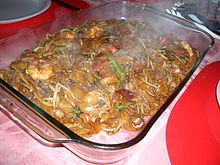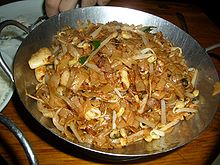- Char kway teow
-
Char kway teow Traditional Chinese 炒粿條 Simplified Chinese 炒粿条 Literal meaning stir-fry ricecake strips (i.e. stir-fried ricecake strips) Transcriptions Mandarin - Hanyu Pinyin chǎo guǒ tiáo Min - Hokkien POJ chhá-kóe-tiâu Cantonese (Yue) - Jyutping caau2 gwo2 tiu4 Alternative name in
Cantonese-speaking regionsTraditional Chinese 炒貴刁 Simplified Chinese 炒贵刁 Literal meaning no literal meaning
(see Etymology)Transcriptions Mandarin - Hanyu Pinyin cháo guì diāo Cantonese (Yue) - Jyutping caau2 gwai3 diu1 Char kway teow, literally "stir-fried ricecake strips", is a popular noodle dish in Malaysia, Indonesia, Brunei and Singapore. The dish was (and still is in some places in Malaysia and Singapore) typically prepared at hawker stalls especially in Penang, Malaysia.
It is made from flat rice noodles (河粉 hé fěn in Mandarin Chinese) of approximately 1 cm or (in the north of Malaysia) about 0.5 cm in width, stir-fried over very high heat with light and dark soy sauce, chilli, a small quantity of belachan, whole prawns, deshelled cockles, bean sprouts and chopped Chinese chives. The dish may commonly be stir-fried with egg, slices of Chinese sausage and fishcake, and less commonly with other ingredients. Char kway teow is traditionally stir-fried in pork fat, with crisp croutons of pork lard, and commonly served on a piece of banana leaf on a plate.
Char kway teow has a reputation of being unhealthy due to its high saturated fat content. However, when the dish was first invented, it was mainly served to labourers. The high fat content and low cost of the dish made it attractive to these people as it was a cheap source of energy and nutrients. When the dish was first served, it was often sold by fishermen, farmers and cockle-gatherers who doubled as char kway teow hawkers in the evening to supplement their income.
Contents
Etymology
The term "char kway teow" is a transliteration of the Chinese characters 炒粿條, pronounced chhá-kóe-tiâu? in Min Nan (also known as Hokkien). The word kóe-tiâu (literally meaning "ricecake strips") generally refers to flat rice noodles, which are the usual ingredient in West Malaysia and Singapore. In East Malaysia, on the other hand, actual sliced ricecake strips are used to make this dish.
In popular transliterations, there is no fixed way of spelling chhá-kóe-tiâu, and many variants can be found: e.g., "char kueh teow", "char kueh tiao", etc.
Owing to the dish's popularity and spread to Cantonese-speaking areas, the term "char kway teow" has been corrupted into "炒貴刁" in Cantonese. This is pronounced as caau2 gwai3 diu1? in Cantonese and cháo guìdiāo ? in Mandarin. The term "貴刁" has no real meaning, but its pronunciation in Cantonese and Mandarin is similar to "粿條" in Min Nan.
In Hong Kong, "char kway teow" is often known as "Singaporean char kway teow" (星州炒貴刁) or "Penang char kway teow" (炒粿條), indicating the dish's origins.
Variations
As the dish has become increasingly popular, many cooks have come up with their own interpretations of the same basic main ingredient of ricecake strips/flat rice noodles fried with anything from eggs (chicken or duck), onions, garlic, prawns, cockles, Chinese sausage, chives, etc.
Of all the notable versions, the Penang style of char kway teow is the most famous. Its popularity leads many char koay teow sellers outside Penang to call their products "Penang char koay teow" in order to attract customers.
In the past it was usual to stir-fry char kway teow in pork fat without eggs (which were, however, available on request). More recently, ordinary cooking oil is commonly used for health or religious reasons, and eggs have become a standard ingredient in the dish.
The char kway teow in Kampar, Perak, Malaysia, is served with cockles but with no prawns (although prawns may be available on request). According to old Kampar char kway teow sellers, this is because Kampar was not near any source of fresh prawns. Kampar char kway teow is also slightly sour.
In other parts of Malaysia, such as Miri in East Malaysia, additional ingredients may include beef, onions, sweet soya sauce, etc. Versions of char koay teow prepared by Muslims in Malaysia will exclude pork fat and may include extra soy sauces and spices and the use of broader-width flat rice noodles. There are also vegetarian varieties that may or may not include eggs.
There are also "gourmet" versions of char kway teow, commonly found in Ipoh and Penang, where the dish may be prepared with more seafood, with crab meat[1] and with duck eggs.
In Indonesia, the dish is known as Kwetiau Goreng (Indonesian: fried flat rice noodles) and is served in Chinese restaurants and by traveling street hawkers. The Indonesian version is less oily, uses no lard, and normally incorporates beef or chicken to cater to the majority Muslim population. However, some Chinese restaurants in Indonesia that serve non-Muslim customers do use pork and pork fat.
Char kway teow is also popular at takeaways in Australia and New Zealand, where it may appear on the menu as 'Kwai Due' or some variant spelling thereof.
In Myanmar, a variety called the Beik Kut kyae kaik (the Beik Scissor Cut) exists. It is popular in the southern coastal regions around the town of Myeik ("Baik" is the Burmese pronunciation) and in Yangon, the largest city in the country. It uses more pepper and seafood compared to the kway teow of Singapore and Malaysia. The rice noodles are slightly thinner and are stir-fried with boiled yellow peas, bean sprouts, squid and prawns, spring onions and dark sweet soy sauce. After being stir-fried, the noodles are cut with scissors (kut kyae in Burmese), thus its name. In many Asian fusion restaurants in America, such as the popular Cafe Asia chain, this dish is offered under the name Gway Tiao.
Many Southeast Asian restaurants in Hong Kong offer char kway teow as a Malay specialty although it is of Southeast Asian Chinese origin. The char kway teow served in Hong Kong is an entirely different dish: stir-fried Chinese-style flat rice noodles with prawns, char siu, onions, and bean sprouts, seasoned with curry and bright yellow in colour. In some places this is known as Fried "Good Dale", a transliteration of the characters "炒貴刁".[2]
In Vietnamese cuisine, a similar stir-fried noodle dish is called hủ tiếu. Thai cuisine has its own version called pad see ew.
In Singapore, char kway teow has evolved into a healthier version with more vegetables and less oil. Furthermore, the greens and bean sprouts gives off a fresh, crunchy texture that makes its taste even more unique.[3]
See also
References
- ^ "Char Kway Teow – Penang – Sister". sigmatestudio.com. http://sigmatestudio.com/2010/03/char-kway-teow-penang-sister/. Retrieved 2010-03-28.
- ^ 'Fried Good Dale: A Translation Run Amok'
- ^ YourSingapore.com - Char Kway Teow
External links
Malaysian cuisine by ethnicity Malay - Asam Pedas
- Belacan
- Budu
- Keropok lekor
- Ketupat
- Kuih
- Lontong
- Nasi Dagang
- Nasi lemak
- Nasi ulam
Chinese - Bakkwa
- Bak kut teh
- Pao
- Char kway teow
- Chee Cheong fun
- Hainanese Chicken Rice
- Hokkien mee
- Pan Mee
- Popiah
- Tong sui
- Wonton mee
- Yong Tau Foo
Indian Nyonya Other - ABC
- Cendol
- Mee goreng
- Nasi Goreng
- Nasi goreng paprik
- Rojak
- Satay
See also: List of Malaysian dishesChinese noodles Ants climbing a tree • Ban mian • Beef chow fun • Beef noodle soup • Biángbiáng noodles • Cart noodle • Cellophane noodles • Champon • Char kway teow • Chow mein • Cu mian • Crossing the bridge noodles • Dan dan noodles • Henan braised noodles • Hokkien mee • Jook-sing noodles • Ka tieu • Lamian • Lai fun • Liang pi • Lo mein • Mee pok • Mi xian • Millinge • Misua • Mung bean sheets • Oil noodles • Re gan mian • Rice noodles • Rice vermicelli • Saang mein • Satay bee hoon • Shahe fen • Shanghai fried noodles • Shrimp roe noodles • Silver needle noodles • Wonton noodles • Yi mein • You mian • Zha jiang mianCategories:- Min Nan words and phrases
- Malaysian noodles
- Malaysian cuisine
- Hong Kong cuisine
- Singaporean cuisine
- Singaporean noodles
- Chinese noodles
Wikimedia Foundation. 2010.



